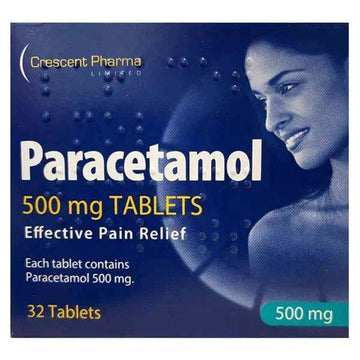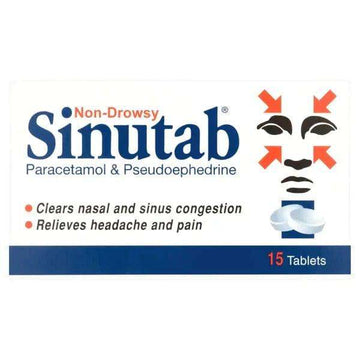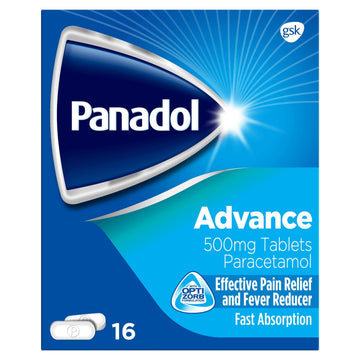Paracetamol is one of the most widely used painkillers in the UK, known for its effectiveness in relieving mild to moderate pain. Whether you're managing headaches, toothaches, or general body aches, paracetamol provides quick relief without the need for stronger medications. Unlike NSAIDs, paracetamol is gentle on the stomach, making it a preferred choice for many people. Available in various forms such as tablets, capsules, and liquid, paracetamol can be easily incorporated into your daily routine to help reduce fever, alleviate discomfort, and support recovery from illness or injury.
If you're looking for additional relief, our Pain Relief collection offers a wide range of options tailored to various pain types.
How Does Paracetamol Work?
Paracetamol works by blocking the production of chemicals called prostaglandins, which are responsible for causing pain and inflammation in the body. By reducing the levels of these chemicals, paracetamol helps to relieve pain and lower fever. It is especially effective for conditions where inflammation is not the primary cause of the pain, such as headaches, muscle aches, and minor aches related to cold and flu.
For fast-acting relief with a cooling sensation, consider checking out Biofreeze for targeted pain relief in muscle and joint areas.
Benefits of Paracetamol
-
Quick and effective pain relief
-
Gentle on the stomach, ideal for sensitive individuals
-
Suitable for a wide range of pain, including headaches and toothaches
-
Helps reduce fever and manage cold symptoms
-
Easily accessible in multiple forms, including liquid, tablet, and caplet
How to Use Paracetamol
Follow the recommended dosage as outlined on the packaging or as directed by your healthcare provider. For tablets and capsules, take with water, and avoid exceeding the maximum daily dose. If using liquid paracetamol, ensure you use the correct measuring spoon or syringe. Always consult a healthcare professional if you're unsure about the appropriate dosage or if you're already using other medications.
Explore our Pain Relief collection for additional complementary treatments and pain relief solutions.
When Should You Use Paracetamol?
Paracetamol is ideal for managing everyday aches and pains, such as headaches, muscle strains, toothaches, or minor arthritis discomfort. It’s also frequently used to reduce fever in both adults and children. Because it is gentle on the stomach, it is often recommended for those who cannot tolerate other painkillers, such as NSAIDs. Always follow the instructions carefully and seek medical advice if you're unsure about its use.
Explore more about Paracetamol tablets in our blog: Best Paracetamol Tablets for expert recommendations and usage tips.
Paracetamol
Paracetamol is one of the most widely used painkillers in the UK, known for its effectiveness in relieving mild to moderate pain. Whether you're managing headaches, toothaches, or general body aches, paracetamol provides quick relief without the need for stronger medications. Unlike NSAIDs, paracetamol is gentle on the stomach, making it a preferred choice for many people. Available in various forms such as tablets, capsules, and liquid, paracetamol can be easily incorporated into your daily routine to help reduce fever, alleviate discomfort, and support recovery from illness or injury.
If you're looking for additional relief, our Pain Relief collection offers a wide range of options tailored to various pain types.
How Does Paracetamol Work?
Paracetamol works by blocking the production of chemicals called prostaglandins, which are responsible for causing pain and inflammation in the body. By reducing the levels of these chemicals, paracetamol helps to relieve pain and lower fever. It is especially effective for conditions where inflammation is not the primary cause of the pain, such as headaches, muscle aches, and minor aches related to cold and flu.
For fast-acting relief with a cooling sensation, consider checking out Biofreeze for targeted pain relief in muscle and joint areas.
Benefits of Paracetamol
-
Quick and effective pain relief
-
Gentle on the stomach, ideal for sensitive individuals
-
Suitable for a wide range of pain, including headaches and toothaches
-
Helps reduce fever and manage cold symptoms
-
Easily accessible in multiple forms, including liquid, tablet, and caplet
How to Use Paracetamol
Follow the recommended dosage as outlined on the packaging or as directed by your healthcare provider. For tablets and capsules, take with water, and avoid exceeding the maximum daily dose. If using liquid paracetamol, ensure you use the correct measuring spoon or syringe. Always consult a healthcare professional if you're unsure about the appropriate dosage or if you're already using other medications.
Explore our Pain Relief collection for additional complementary treatments and pain relief solutions.
When Should You Use Paracetamol?
Paracetamol is ideal for managing everyday aches and pains, such as headaches, muscle strains, toothaches, or minor arthritis discomfort. It’s also frequently used to reduce fever in both adults and children. Because it is gentle on the stomach, it is often recommended for those who cannot tolerate other painkillers, such as NSAIDs. Always follow the instructions carefully and seek medical advice if you're unsure about its use.
Explore more about Paracetamol tablets in our blog: Best Paracetamol Tablets for expert recommendations and usage tips.
-
Vendor:Generic Brand
Paracetamol
22 ReviewsRegular price From £0.41Regular price Sale price From £0.41Vendor:ParacetamolParacetamol Tablets 500mg Pack of 32
72 ReviewsRegular price £1.17Regular price Sale price £1.17Vendor:PanadolPanadol Night Tablets Pack of 20
64 ReviewsRegular price £6.00Regular price Sale price £6.00Vendor:CareRegular price £7.99Regular price Sale price £7.99Vendor:NuromolNuromol Dual Action Pain Relief Tablets
78 ReviewsRegular price From £4.07Regular price Sale price From £4.07Vendor:AnadinAnadin Extra Caplets
40 ReviewsRegular price From £2.00Regular price Sale price From £2.00Vendor:SolpadeineSolpaOne Effervescent Tablets Pack of 12
80 ReviewsRegular price £5.69Regular price Sale price £5.69Vendor:SinutabSinutab Tablets Non-drowsy Pack of 15
74 ReviewsRegular price £5.31Regular price Sale price £5.31Vendor:LemsipLemsip Cold & Flu Lemon Pack of 10
68 ReviewsRegular price £3.99Regular price Sale price £3.99Vendor:CalpolRegular price £7.22Regular price Sale price £7.22Vendor:PanadolPanadol Extra Soluble Tablets Pack of 24
80 ReviewsRegular price £8.15Regular price Sale price £8.15Save- £2.00Vendor:AspirinAspirin 300mg Tablets Pack of 32
64 ReviewsRegular price £3.19Regular price £5.19 Sale price £3.19SaveFrequently Asked Questions
Is Paracetamol safe to use in pregnancy?
Paracetamol is not just safe but is the first-choice painkiller in pregnancy. It doesn't harm the baby and is a recommended choice in pregnancy.
What are the ill effects/ side effects of Paracetamol?
The use of Paracetamol on a long-term basis causes long-term effects, e.g., stroke & heart diseases in patients with high blood pressure, kidney and liver damage, anaemia, blueness of lips, anaemia, breathlessness, and tiredness.
Does Paracetamol cause sleepiness?
Yes, it causes fatigue and exhaustion, among other side effects. These side effects increase the risk of dangerous side effects. When used with antihistamines, it causes more sleep.
Are paracetamol and Panadol the same?
Yes, the active ingredient in Panadol is the same, e.g., Paracetamol, which relieves pain and improves symptoms associated with back pain, headache, flu, and cold. Both choices are also effective for muscle aches and toothaches.
Does Paracetamol thin blood?
No, its active ingredient, acetaminophen, is not a blood thinner. Other painkillers, such as aspirin, are blood thinners. Acetaminophen relieves fever and pain when used in the appropriate doses.
Buy Together & Save 10%
Your cart is emptyThis quantity of item cannot be added to the cart Continue shoppingYour cartSubtotal$000.00
Free delivery on orders over £50
Spend more to get
You may also like
Site Preferences- Choosing a selection results in a full page refresh.
- Opens in a new window.
Buy Together & Save 10%





















